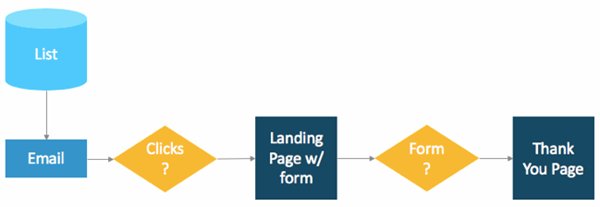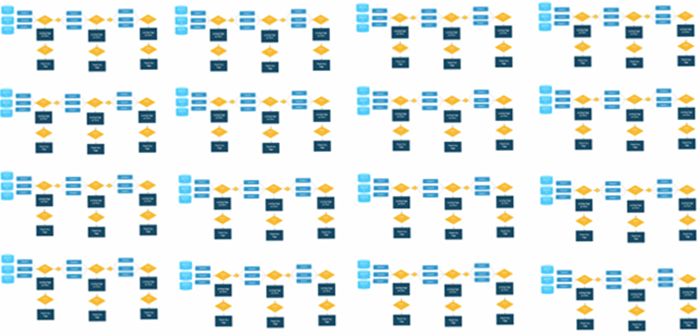Marketing automation is not a new concept to B2B marketers by any stretch of the imagination, but the extent to which marketers use their marketing automation platform (MAP) is a different story.
When making the transition to marketing automation, many B2B organizations find scale to be the biggest issue they face. Let's look at an example.
Before marketing automation, you may have had the luxury of focusing on a single email or single event. You identified a list, you created your email, with a landing page that may or may not include a form, and you launched that email at a certain day and time. Your flow may have looked like this:

With marketing automation, you can scale your campaigns to include multiple touches across the buying journey, significantly increasing your ability to engage with your customers and prospects.
For example, you can create email nurture campaigns that drip email messages over a span of time, and you can personalize that message based on a particular segment of your target audience.
The following illustrated flow showcases a campaign with multiple touches and multiple segments. You can also automate this campaign to be evergreen: As records qualify for the campaign, they can enter into the flow:

Based on those two scenarios outlined above, we see a 3X increase in effort on your marketing organization. The good news? Once you've completed the multitouch campaign, it can now run in the background while you focus on the next multitouch campaign. Eventually, you will end up with an entire ecosystem of campaigns that looks something like this:

Wow, that's a lot of campaigns! No wonder scale can be a huge barrier to adopting marketing automation and demand generation campaigns.
Before marketing automation, you could focus on only one campaign at a time; but with marketing automation, the numbers explode! How do you maximize your time, resources, and processes to get the desired campaign results?
In my experience, most organizations ready themselves for the technology, and they may add some resources to account for scale, but the process itself is dotted with numerous barriers.
Here, I'll walk you through 10 "gotchas" I've observed over the years in relation to scaling your demand generation campaigns with marketing automation. These 10 scenarios regularly pop up like brick walls for those new to executing campaigns within marketing automation.
1. Your list count is too small
Consistently, campaign success is attributed to personalization. As marketers, we strive to deliver the right message at the right time to the right audience. One of the first exercises you should do, before you put any work into a campaign design, is to understand how many leads you have in your database that match your target audience.
For a variety of reasons, that number could be small. Maybe you don't have the data on the records that would segment that record into that audience. It could even be that you don't have any records that fit your criteria. If you don't have enough data to tell, enrich your database to obtain those data points. You can also structure your campaign strategy toward acquisition of leads if the count is still too low.
2. Lists are not marketable
In addition to making sure your target audiences are large enough to merit a campaign, you need to look at how marketable a list may be. For example, many B2B marketers want to target decision makers in the C-suite. Good luck engaging that audience via email… You'll be much more successful with a more ABM-campaign approach that involves your sales team. You need to match the channel to the target audience. In addition, your segmentation needs to be based on real data. If you are trying to segment your audience based on criteria that doesn't exist, you may need to get creative in how that persona criteria manifest into data points.
3. Too many stakeholders are involved
Too many cooks in the kitchen for design and testing will slow down any launch. At the beginning of your campaign planning and design session, identify the roles of the team members. Who needs to approve the campaign? Who will be responsible for testing the campaign? Who will gather feedback from your stakeholders?
And identify your stakeholders. If you have more than two stakeholders, I would suggest electing a single person to gather all stakeholder feedback so you aren't stuck receiving multiple rounds or conflicting feedback. Also designate a timeline as to when to receive feedback. If feedback is received outside that timeline, your campaign launch will be delayed.
4. Content is not ready
This obstacle always seems to sneak up on people. Most marketers dive deep into the technology, data, copy, etc. and sometimes lose sight of content timelines. This issue gets especially tricky when you are working with a creative agency or an internal agency that is juggling your work requests with those of others.
At the beginning of your campaign planning, identify content barriers. Are you asking for a net-new piece of content? Have you identified a piece of content that can be repurposed for this campaign?
Understanding the level of effort to both create the base content (ideas, copy, theme, etc.) the media (audio, visual, text, video) will have a high impact on your campaign timelines.
I like to have a backup plan for my campaigns: an alternate content piece I can use. With a strong content repurposing strategy, you can reuse and extend the lifetime of your content so that you aren't stuck with a campaign and no content to fuel engagement.
5. You forget inbound
Marketers who first encounter marketing automation tend to focus on using an outbound strategy. Email is consistently named one of the most effective and efficient channels by B2B marketers; however, excluding inbound efforts from, or not blending them into, demand generation campaigns can diminish your results.
Identify your channels early in the planning process. Set aside budget and stress-test your target audience within the channels you have selected. It takes multiple touches across multiple channels to earn the engagement of your audience. Don't limit yourself to email.
Your marketing automation platform can and should integrate with your inbound efforts, so you can amplify your results.
6. Success criteria are not documented
More leads, right? That's the success of our demand generation campaigns! Wrong. Be strategic and specific with your success criteria. Are you trying to engage a specific audience? Increase their lead score? Convert them to MQLs? The more specific you are in your success criteria, the easier it will be to optimize your campaigns. You will also be able to create reports that fit your requirements.
Data plays a huge part in measuring the success of your campaigns. Make sure your success criteria are specific enough to give you the data you need to analyze and optimize your campaigns.
7. You fail to alert your 'from address' stakeholders
Sending your emails from a person rather than a corporate address is a great practice. Because it feels more personal, it can start a better digital relationship with your target audience. Don't worry, your brand will still be prominent enough that recipient will see who is sending the email. Let's say you want to use a particular salesperson's email address for an email send or campaign. Make sure you reach out to that salesperson and help them create a foldering rule so they don't get hundreds (or thousands) of autoresponder emails flooding their inbox.
8. You fail to configure alert emails to Sales
In addition to working with Sales for replies, Marketing needs to make sure the right alerts are set up for the campaign and to weigh those alerts with any other alerts your salespeople may be receiving. An email alert for a contact or demo request may be appropriate to send to Sales, but make sure you are using your lead management process to send those emails. If you send alerts custom to each campaign, your sales team may begin to ignore alert emails and ultimately your MQLs may lag in follow-up response.
9. There are unproven email and landing-page templates in the MAP
All marketing automation platforms have their particularities in regard to HTML email and landing page templates. Don't assume the template your creative agency has provided for a campaign will work smoothly with your platform. Build in time to test the functionality and rendering of a new template.
Another way to support scale is to move away from custom templates per campaign. Create 3-5 templates that can work across many campaigns. You'll find this approach will save a lot of time and headache.
You can test your emails on platforms such as EmailOnAcid or Litmus. Be thorough in your testing, because there are numerous email service providers with slight variations in email rendering.
10. Sales wasn't trained on how to interpret CRM campaign data
If I had a dime for every time someone forgot to connect their demand generation campaign data to their CRM, I'd be rich! However, if your marketing automation platform connects to your CRM, a huge advantage to this integration is the passing of campaign data and digital interactions from Marketing to Sales. Help your sales team learn to read and interpret your target audience's digital body behavior. Doing that will strengthen your relationship with Sales, also providing insight into Marketing's campaign efforts.
* * *
These 10 scenarios might seem detail-oriented, but they can be real barriers—especially when you are on a launch deadline. To learn how to avoid these barriers by using the right people, processes, and technology, I encourage you to check out my course with Marketing Profs titled Communicating Your Demand Generation Programs and Campaigns. You can access course details here. And check out additional materials on marketing automation pitfalls and myths.




